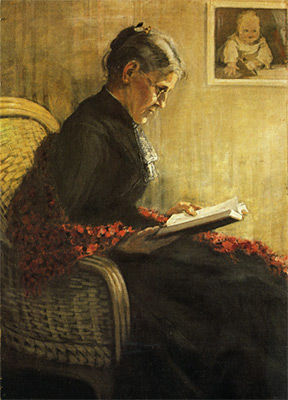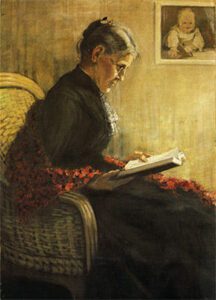
Portrait of the Artist's Mother (1902)

Franz Marc was born in Munich in 1880. He died near Verdun in 1916, legally murdered in what was called The War To End All Wars. A war which slaughtered over a million men.
Marc’s father was a representational animal painter. His son took the language of animal imagery to new symbolic heights. In 1901, abandoning his philosophy course, he enrolled for two years training at Munich’s Academy of Art. Here he learned to paint in typical Munich School style, which combines traditional composition with delicate, subtly emotional colours. There is no sign here of the glowing colours and leaping, fractured forms of his later work. In 1903 he went to Paris, then very much the centre of the modern art world, to be powerfully moved by the Impressionists with their brilliant colours and more openly contemporary subject matter and style. He saw real rivers, real dance halls, real unidealized men and women, people and landscapes painted outdoors in a bold, abbreviated style. The daringly simplified composition of Japanese woodcuts, then highly popular, also attracted him. These inspiring influences enabled him to lighten his colours and simplify his forms.
A second visit to Paris in 1907 showed him the work of Gauguin and Van Gogh, who tremendously excited him. His paintings now became much less static, more rhythmical, and he started painting outdoors. These advances only occurred in his landscapes, however, and from now on human figures largely disappeared and animals, already a favourite subject, became much dominant. He verbalized this as a choice between natural and unnatural, pure and impure, with animals definitely seen as superior. Without at this stage abandoning the naturalistic style Marc, an intense, spiritual young man, sought a deeper spiritual subject matter in animals. He also studied animal anatomy at this time, but already his work is miles away from his father’s strictly representational animal paintings.
Now everything seems to happen at incredible speed. In 1910 Marc paints his ground-breaking Horse in a Landscape, with its red horse with a blue mane gazing into a drastically simplified landscape composed of colour areas of red, yellow and green. Still more simplified are the glowing forms of the Yellow Cow and Blue Fox of 1911. He meets Kandinsky, who is already moving from simplified forms to abstraction, becomes involved with the Blue Rider group, acquired his first patron, Koehler, and systematically develops a language of colour symbolism. Basically, blue is masculine, spiritual and austere, yellow is feminine, sensual and light-hearted (that yellow cow is a real flirt!) and red represents the heaviness and brutality of the material world. These can be endlessly contrasted and combined.
Another great leap forward occurs with the geometric forms of the Tiger and Gazelle of 1912, and in Horse Dreaming (1913) and Tyrol (1913-14) we see how successfully Marc has absorbed Cubist, Orphist and Futuristic influences.
Around 1913 Marc began seeing ugliness in animals as well as humans. Animals in his work accordingly became increasingly stylized and symbolic. Hence the swooping, swirling, fragmented forms of Mandrill (1913), Composition of Abstract Forms (1914), Blue Roe in Landscape (1914) and Abstract Forms (1914).
Marc joined up immediately when war broke out in August 1914. He wrote to Kandinsky of seeing war as both a great adventure and “the only way of cleaning out the Augean stable that is Europe”. Like so many he visualized war as a way of purging a corrupt, decaying world. Eighteen months later, he was dead.
Jane Sand
Jane Sand is an artist who lives and works in Penwith.
volume 32 no 5 May / June 2018 p 34

